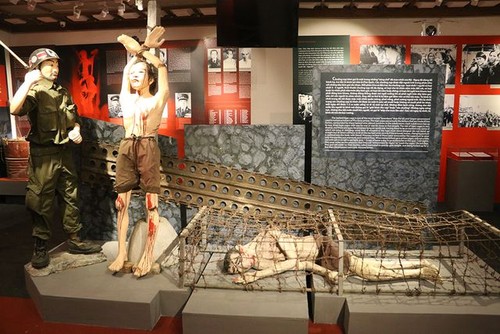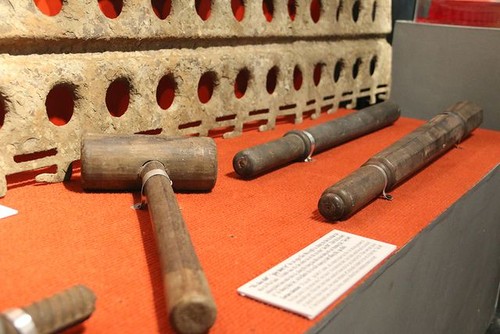 Tiger cages are among the most cruel modes of torture against Vietnamese revolut prisoners during the anti-American war. (Photo: vietnamnet.vn) Tiger cages are among the most cruel modes of torture against Vietnamese revolut prisoners during the anti-American war. (Photo: vietnamnet.vn) |
On display are nearly 300 items, documents and photos honoring revolutionaries who were imprisoned during Vietnam’s two national resistance wars against the French and American invaders. The exhibition is divided into 3 sections. The 1st section called “Hell on earth” depicts war cruelty at Hoa Lo, Con Dao and Phu Quoc prisons where the prisoners were brutally tortured: being kept in the notorious tiger cages or experiencing electric shocks. The 2nd section features the prisoners’ strong will and staunchness during those years of hardship and how they used their time behind bars to improve their knowledge and contribute to the revolution. The last section entitled “Day of victory” spotlights prisoners who later became key Party and State leaders such as Do Muoi, Song Hao, Pham Hong Cu, and Nguyen Luong Bang. Nguyen Thi Anh, a visitor from Hanoi, told VOV: "I admire the revolutionary prisoners’ undaunted spirit. The enemies’ torture only strengthened their iron will to fight for freedom. Young people like me learn a lot from them who were willing to die for national independence."
 Tools used to torture prisoners. (Photo: internet) Tools used to torture prisoners. (Photo: internet) |
Dao Van Kim of Bac Ninh, a former revolutionary prisoner, said: "Photos on display remind us of our struggles and our unlucky comrades who lost their life in prisons. We’re all touched and proud that we did our very best for national freedom."
Lam Van Bang who managed to escape Phu Quoc prison has traveled across Vietnam to collect items left by Vietnamese revolutionary soldiers who died in prisons to pay tribute to them and educate the younger generations of their predecessors’ patriotism and heroism. Bang, who is now Director of a museum on Vietnamese revolutionary prisoners in Hanoi’ Phu Xuyen district, said: "War veterans like me and relatives of fallen soldiers feel fulfilled visiting this exhibition and see with our own eyes the belongings left by the fallen soldiers and understand what they had gone through."
The exhibition pays tribute to revolutionary soldiers who sacrificed for national freedom and independence and rekindles patriotism and the national pride among young people.